Analyzing the Impact of Business Intelligence on Strategic Decisions
VerifiedAdded on 2022/03/08
|13
|4001
|30
Report
AI Summary
This report critically examines the influence of Business Intelligence (BI) on strategic decision-making within organizations. It synthesizes findings from five academic journals to demonstrate BI's contribution to enhanced strategic management. The report explores various aspects of BI, including its role as a tool, process, and system, and its impact on data analysis, goal alignment, and the achievement of key performance indicators (KPIs). The review highlights the importance of integrating BI with overall business strategies to improve decision quality and organizational performance. Furthermore, the report delves into the evolution of BI, its definitions, and its application in diverse business contexts, emphasizing the need for a clear understanding of BI's capabilities and limitations. The analysis underscores the competitive advantages that BI provides, emphasizing the importance of aligning BI with overall business strategies and the need for effective data integration and analysis to support informed decision-making.

Paraphrase This Document
Need a fresh take? Get an instant paraphrase of this document with our AI Paraphraser
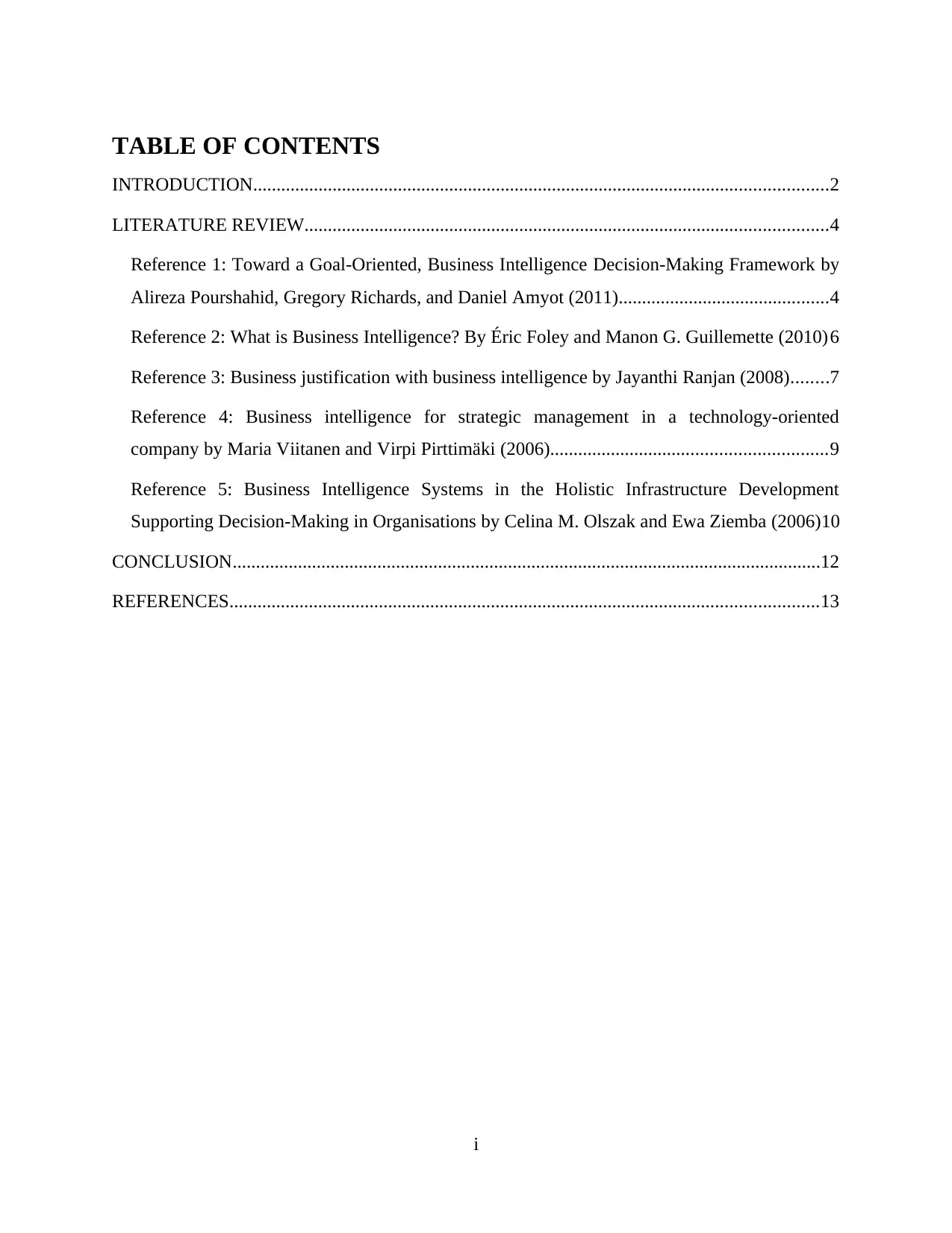
TABLE OF CONTENTS
INTRODUCTION...........................................................................................................................2
LITERATURE REVIEW................................................................................................................4
Reference 1: Toward a Goal-Oriented, Business Intelligence Decision-Making Framework by
Alireza Pourshahid, Gregory Richards, and Daniel Amyot (2011).............................................4
Reference 2: What is Business Intelligence? By Éric Foley and Manon G. Guillemette (2010)6
Reference 3: Business justification with business intelligence by Jayanthi Ranjan (2008)........7
Reference 4: Business intelligence for strategic management in a technology-oriented
company by Maria Viitanen and Virpi Pirttimäki (2006)...........................................................9
Reference 5: Business Intelligence Systems in the Holistic Infrastructure Development
Supporting Decision-Making in Organisations by Celina M. Olszak and Ewa Ziemba (2006)10
CONCLUSION..............................................................................................................................12
REFERENCES..............................................................................................................................13
i
INTRODUCTION...........................................................................................................................2
LITERATURE REVIEW................................................................................................................4
Reference 1: Toward a Goal-Oriented, Business Intelligence Decision-Making Framework by
Alireza Pourshahid, Gregory Richards, and Daniel Amyot (2011).............................................4
Reference 2: What is Business Intelligence? By Éric Foley and Manon G. Guillemette (2010)6
Reference 3: Business justification with business intelligence by Jayanthi Ranjan (2008)........7
Reference 4: Business intelligence for strategic management in a technology-oriented
company by Maria Viitanen and Virpi Pirttimäki (2006)...........................................................9
Reference 5: Business Intelligence Systems in the Holistic Infrastructure Development
Supporting Decision-Making in Organisations by Celina M. Olszak and Ewa Ziemba (2006)10
CONCLUSION..............................................................................................................................12
REFERENCES..............................................................................................................................13
i
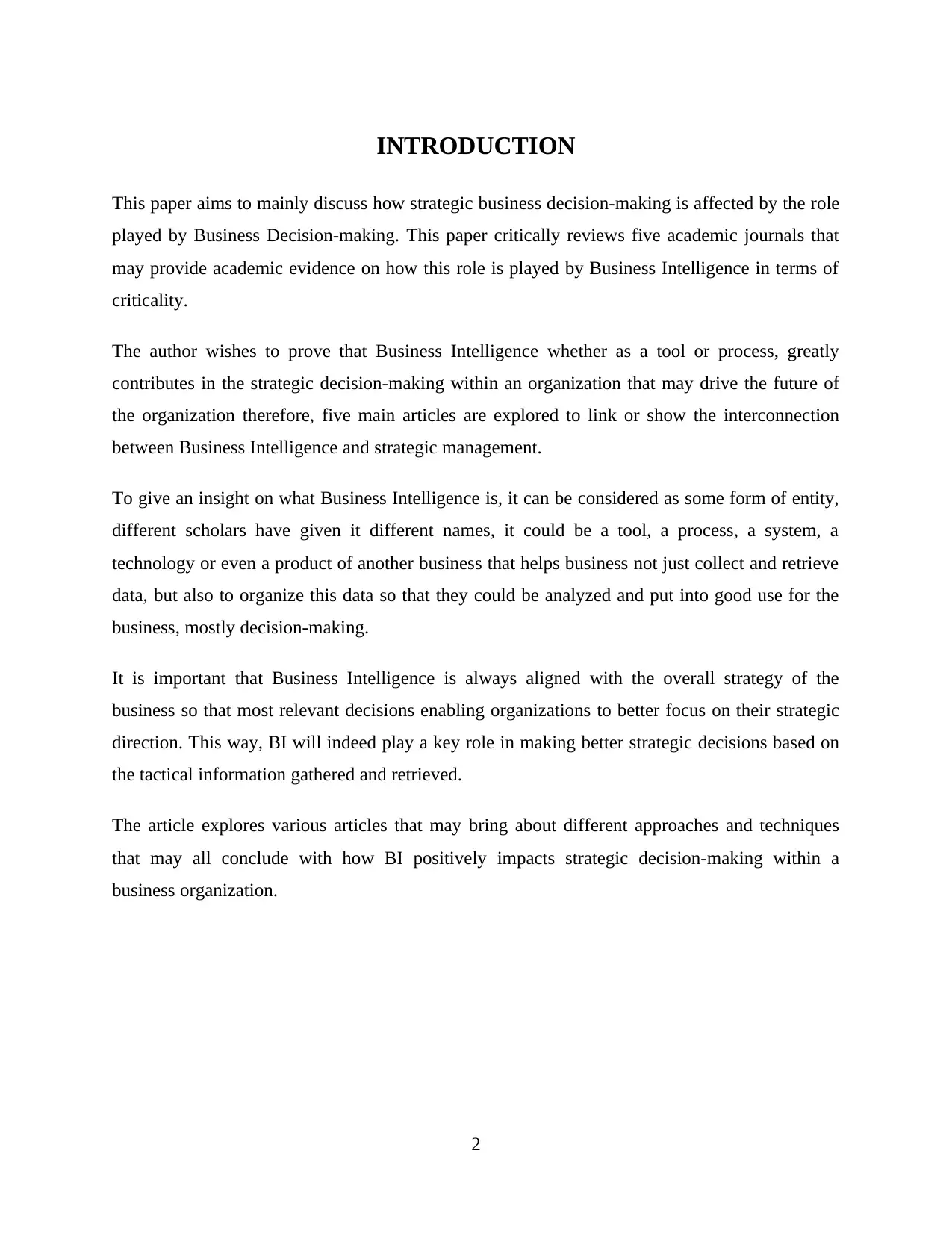
INTRODUCTION
This paper aims to mainly discuss how strategic business decision-making is affected by the role
played by Business Decision-making. This paper critically reviews five academic journals that
may provide academic evidence on how this role is played by Business Intelligence in terms of
criticality.
The author wishes to prove that Business Intelligence whether as a tool or process, greatly
contributes in the strategic decision-making within an organization that may drive the future of
the organization therefore, five main articles are explored to link or show the interconnection
between Business Intelligence and strategic management.
To give an insight on what Business Intelligence is, it can be considered as some form of entity,
different scholars have given it different names, it could be a tool, a process, a system, a
technology or even a product of another business that helps business not just collect and retrieve
data, but also to organize this data so that they could be analyzed and put into good use for the
business, mostly decision-making.
It is important that Business Intelligence is always aligned with the overall strategy of the
business so that most relevant decisions enabling organizations to better focus on their strategic
direction. This way, BI will indeed play a key role in making better strategic decisions based on
the tactical information gathered and retrieved.
The article explores various articles that may bring about different approaches and techniques
that may all conclude with how BI positively impacts strategic decision-making within a
business organization.
2
This paper aims to mainly discuss how strategic business decision-making is affected by the role
played by Business Decision-making. This paper critically reviews five academic journals that
may provide academic evidence on how this role is played by Business Intelligence in terms of
criticality.
The author wishes to prove that Business Intelligence whether as a tool or process, greatly
contributes in the strategic decision-making within an organization that may drive the future of
the organization therefore, five main articles are explored to link or show the interconnection
between Business Intelligence and strategic management.
To give an insight on what Business Intelligence is, it can be considered as some form of entity,
different scholars have given it different names, it could be a tool, a process, a system, a
technology or even a product of another business that helps business not just collect and retrieve
data, but also to organize this data so that they could be analyzed and put into good use for the
business, mostly decision-making.
It is important that Business Intelligence is always aligned with the overall strategy of the
business so that most relevant decisions enabling organizations to better focus on their strategic
direction. This way, BI will indeed play a key role in making better strategic decisions based on
the tactical information gathered and retrieved.
The article explores various articles that may bring about different approaches and techniques
that may all conclude with how BI positively impacts strategic decision-making within a
business organization.
2
⊘ This is a preview!⊘
Do you want full access?
Subscribe today to unlock all pages.

Trusted by 1+ million students worldwide
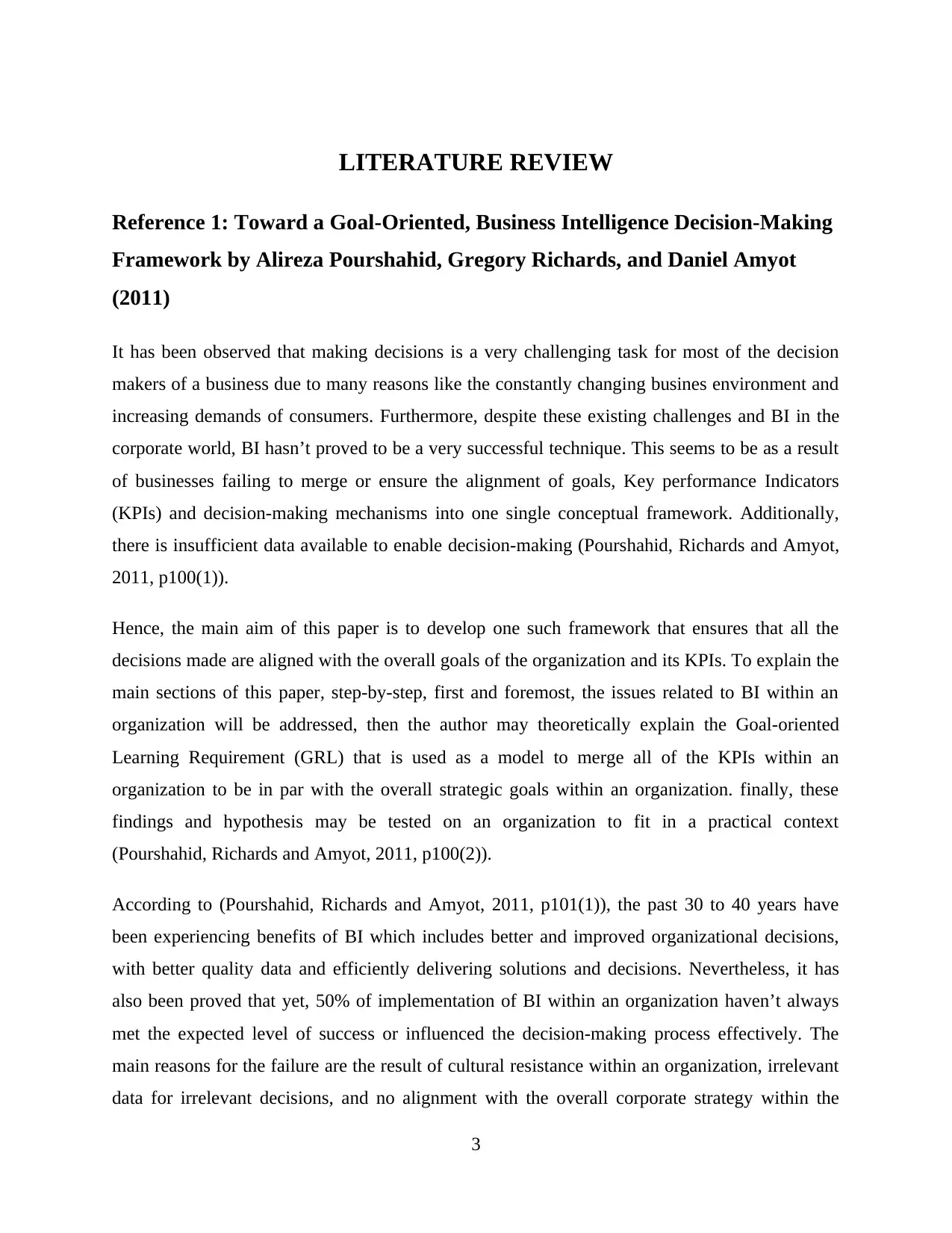
LITERATURE REVIEW
Reference 1: Toward a Goal-Oriented, Business Intelligence Decision-Making
Framework by Alireza Pourshahid, Gregory Richards, and Daniel Amyot
(2011)
It has been observed that making decisions is a very challenging task for most of the decision
makers of a business due to many reasons like the constantly changing busines environment and
increasing demands of consumers. Furthermore, despite these existing challenges and BI in the
corporate world, BI hasn’t proved to be a very successful technique. This seems to be as a result
of businesses failing to merge or ensure the alignment of goals, Key performance Indicators
(KPIs) and decision-making mechanisms into one single conceptual framework. Additionally,
there is insufficient data available to enable decision-making (Pourshahid, Richards and Amyot,
2011, p100(1)).
Hence, the main aim of this paper is to develop one such framework that ensures that all the
decisions made are aligned with the overall goals of the organization and its KPIs. To explain the
main sections of this paper, step-by-step, first and foremost, the issues related to BI within an
organization will be addressed, then the author may theoretically explain the Goal-oriented
Learning Requirement (GRL) that is used as a model to merge all of the KPIs within an
organization to be in par with the overall strategic goals within an organization. finally, these
findings and hypothesis may be tested on an organization to fit in a practical context
(Pourshahid, Richards and Amyot, 2011, p100(2)).
According to (Pourshahid, Richards and Amyot, 2011, p101(1)), the past 30 to 40 years have
been experiencing benefits of BI which includes better and improved organizational decisions,
with better quality data and efficiently delivering solutions and decisions. Nevertheless, it has
also been proved that yet, 50% of implementation of BI within an organization haven’t always
met the expected level of success or influenced the decision-making process effectively. The
main reasons for the failure are the result of cultural resistance within an organization, irrelevant
data for irrelevant decisions, and no alignment with the overall corporate strategy within the
3
Reference 1: Toward a Goal-Oriented, Business Intelligence Decision-Making
Framework by Alireza Pourshahid, Gregory Richards, and Daniel Amyot
(2011)
It has been observed that making decisions is a very challenging task for most of the decision
makers of a business due to many reasons like the constantly changing busines environment and
increasing demands of consumers. Furthermore, despite these existing challenges and BI in the
corporate world, BI hasn’t proved to be a very successful technique. This seems to be as a result
of businesses failing to merge or ensure the alignment of goals, Key performance Indicators
(KPIs) and decision-making mechanisms into one single conceptual framework. Additionally,
there is insufficient data available to enable decision-making (Pourshahid, Richards and Amyot,
2011, p100(1)).
Hence, the main aim of this paper is to develop one such framework that ensures that all the
decisions made are aligned with the overall goals of the organization and its KPIs. To explain the
main sections of this paper, step-by-step, first and foremost, the issues related to BI within an
organization will be addressed, then the author may theoretically explain the Goal-oriented
Learning Requirement (GRL) that is used as a model to merge all of the KPIs within an
organization to be in par with the overall strategic goals within an organization. finally, these
findings and hypothesis may be tested on an organization to fit in a practical context
(Pourshahid, Richards and Amyot, 2011, p100(2)).
According to (Pourshahid, Richards and Amyot, 2011, p101(1)), the past 30 to 40 years have
been experiencing benefits of BI which includes better and improved organizational decisions,
with better quality data and efficiently delivering solutions and decisions. Nevertheless, it has
also been proved that yet, 50% of implementation of BI within an organization haven’t always
met the expected level of success or influenced the decision-making process effectively. The
main reasons for the failure are the result of cultural resistance within an organization, irrelevant
data for irrelevant decisions, and no alignment with the overall corporate strategy within the
3
Paraphrase This Document
Need a fresh take? Get an instant paraphrase of this document with our AI Paraphraser
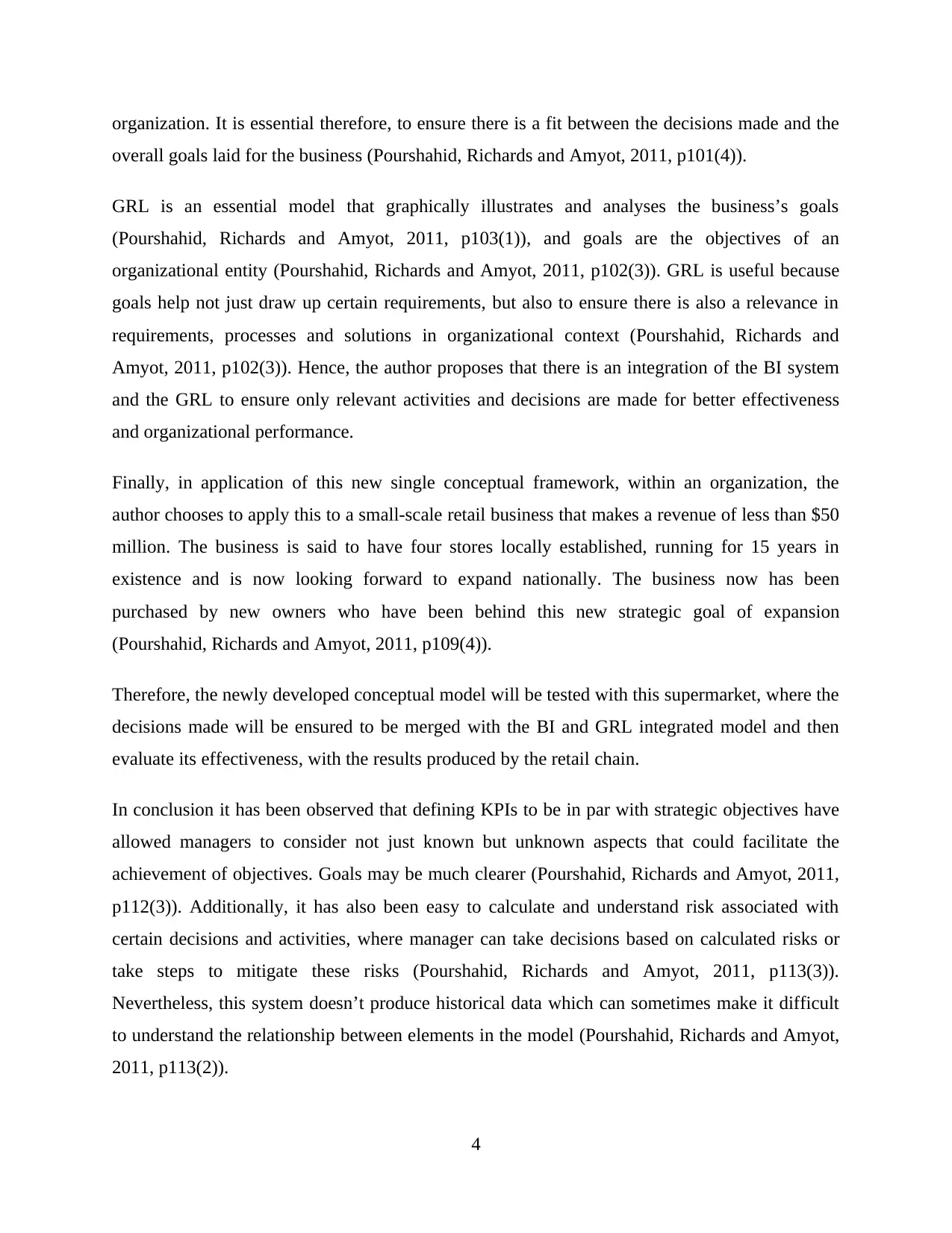
organization. It is essential therefore, to ensure there is a fit between the decisions made and the
overall goals laid for the business (Pourshahid, Richards and Amyot, 2011, p101(4)).
GRL is an essential model that graphically illustrates and analyses the business’s goals
(Pourshahid, Richards and Amyot, 2011, p103(1)), and goals are the objectives of an
organizational entity (Pourshahid, Richards and Amyot, 2011, p102(3)). GRL is useful because
goals help not just draw up certain requirements, but also to ensure there is also a relevance in
requirements, processes and solutions in organizational context (Pourshahid, Richards and
Amyot, 2011, p102(3)). Hence, the author proposes that there is an integration of the BI system
and the GRL to ensure only relevant activities and decisions are made for better effectiveness
and organizational performance.
Finally, in application of this new single conceptual framework, within an organization, the
author chooses to apply this to a small-scale retail business that makes a revenue of less than $50
million. The business is said to have four stores locally established, running for 15 years in
existence and is now looking forward to expand nationally. The business now has been
purchased by new owners who have been behind this new strategic goal of expansion
(Pourshahid, Richards and Amyot, 2011, p109(4)).
Therefore, the newly developed conceptual model will be tested with this supermarket, where the
decisions made will be ensured to be merged with the BI and GRL integrated model and then
evaluate its effectiveness, with the results produced by the retail chain.
In conclusion it has been observed that defining KPIs to be in par with strategic objectives have
allowed managers to consider not just known but unknown aspects that could facilitate the
achievement of objectives. Goals may be much clearer (Pourshahid, Richards and Amyot, 2011,
p112(3)). Additionally, it has also been easy to calculate and understand risk associated with
certain decisions and activities, where manager can take decisions based on calculated risks or
take steps to mitigate these risks (Pourshahid, Richards and Amyot, 2011, p113(3)).
Nevertheless, this system doesn’t produce historical data which can sometimes make it difficult
to understand the relationship between elements in the model (Pourshahid, Richards and Amyot,
2011, p113(2)).
4
overall goals laid for the business (Pourshahid, Richards and Amyot, 2011, p101(4)).
GRL is an essential model that graphically illustrates and analyses the business’s goals
(Pourshahid, Richards and Amyot, 2011, p103(1)), and goals are the objectives of an
organizational entity (Pourshahid, Richards and Amyot, 2011, p102(3)). GRL is useful because
goals help not just draw up certain requirements, but also to ensure there is also a relevance in
requirements, processes and solutions in organizational context (Pourshahid, Richards and
Amyot, 2011, p102(3)). Hence, the author proposes that there is an integration of the BI system
and the GRL to ensure only relevant activities and decisions are made for better effectiveness
and organizational performance.
Finally, in application of this new single conceptual framework, within an organization, the
author chooses to apply this to a small-scale retail business that makes a revenue of less than $50
million. The business is said to have four stores locally established, running for 15 years in
existence and is now looking forward to expand nationally. The business now has been
purchased by new owners who have been behind this new strategic goal of expansion
(Pourshahid, Richards and Amyot, 2011, p109(4)).
Therefore, the newly developed conceptual model will be tested with this supermarket, where the
decisions made will be ensured to be merged with the BI and GRL integrated model and then
evaluate its effectiveness, with the results produced by the retail chain.
In conclusion it has been observed that defining KPIs to be in par with strategic objectives have
allowed managers to consider not just known but unknown aspects that could facilitate the
achievement of objectives. Goals may be much clearer (Pourshahid, Richards and Amyot, 2011,
p112(3)). Additionally, it has also been easy to calculate and understand risk associated with
certain decisions and activities, where manager can take decisions based on calculated risks or
take steps to mitigate these risks (Pourshahid, Richards and Amyot, 2011, p113(3)).
Nevertheless, this system doesn’t produce historical data which can sometimes make it difficult
to understand the relationship between elements in the model (Pourshahid, Richards and Amyot,
2011, p113(2)).
4
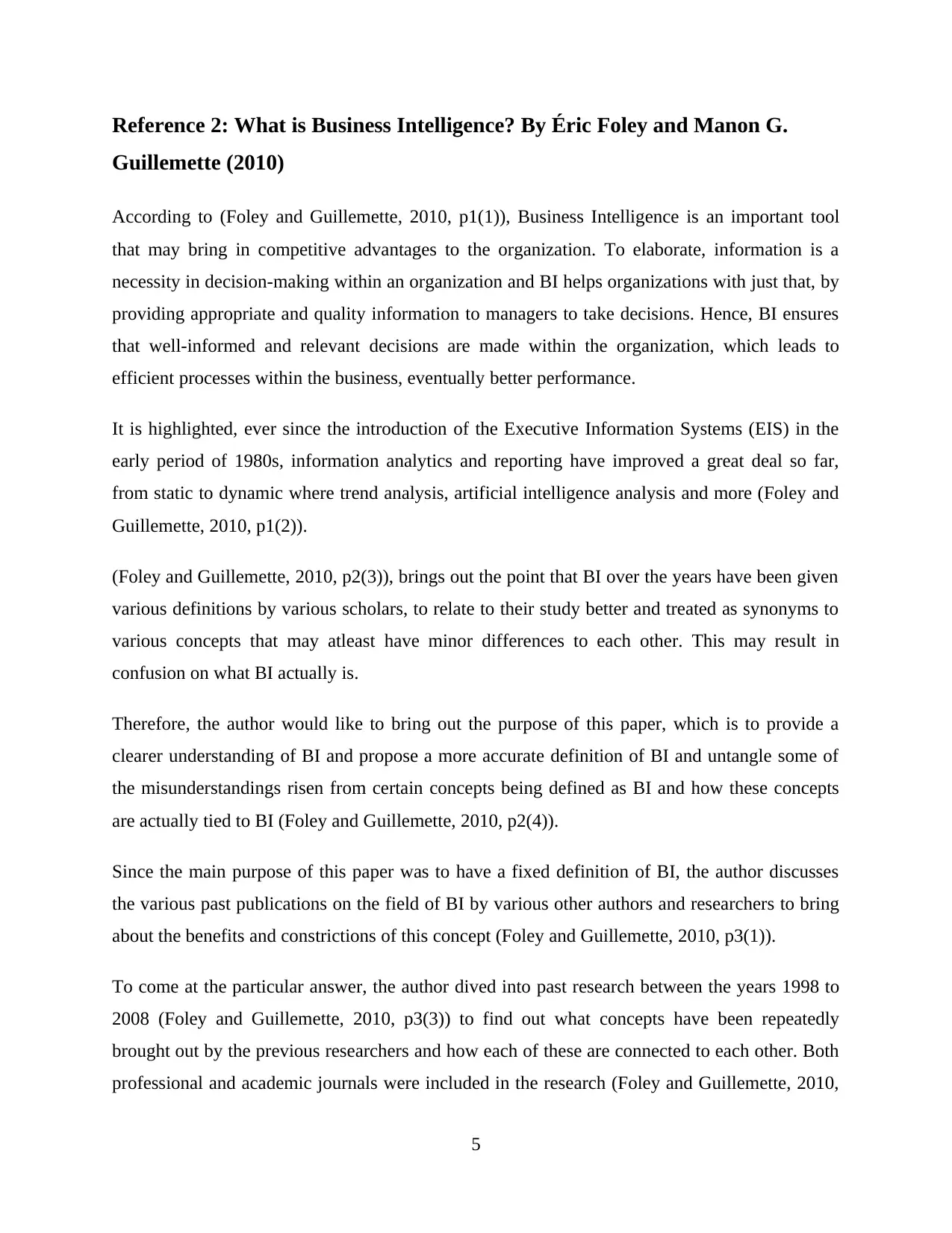
Reference 2: What is Business Intelligence? By Éric Foley and Manon G.
Guillemette (2010)
According to (Foley and Guillemette, 2010, p1(1)), Business Intelligence is an important tool
that may bring in competitive advantages to the organization. To elaborate, information is a
necessity in decision-making within an organization and BI helps organizations with just that, by
providing appropriate and quality information to managers to take decisions. Hence, BI ensures
that well-informed and relevant decisions are made within the organization, which leads to
efficient processes within the business, eventually better performance.
It is highlighted, ever since the introduction of the Executive Information Systems (EIS) in the
early period of 1980s, information analytics and reporting have improved a great deal so far,
from static to dynamic where trend analysis, artificial intelligence analysis and more (Foley and
Guillemette, 2010, p1(2)).
(Foley and Guillemette, 2010, p2(3)), brings out the point that BI over the years have been given
various definitions by various scholars, to relate to their study better and treated as synonyms to
various concepts that may atleast have minor differences to each other. This may result in
confusion on what BI actually is.
Therefore, the author would like to bring out the purpose of this paper, which is to provide a
clearer understanding of BI and propose a more accurate definition of BI and untangle some of
the misunderstandings risen from certain concepts being defined as BI and how these concepts
are actually tied to BI (Foley and Guillemette, 2010, p2(4)).
Since the main purpose of this paper was to have a fixed definition of BI, the author discusses
the various past publications on the field of BI by various other authors and researchers to bring
about the benefits and constrictions of this concept (Foley and Guillemette, 2010, p3(1)).
To come at the particular answer, the author dived into past research between the years 1998 to
2008 (Foley and Guillemette, 2010, p3(3)) to find out what concepts have been repeatedly
brought out by the previous researchers and how each of these are connected to each other. Both
professional and academic journals were included in the research (Foley and Guillemette, 2010,
5
Guillemette (2010)
According to (Foley and Guillemette, 2010, p1(1)), Business Intelligence is an important tool
that may bring in competitive advantages to the organization. To elaborate, information is a
necessity in decision-making within an organization and BI helps organizations with just that, by
providing appropriate and quality information to managers to take decisions. Hence, BI ensures
that well-informed and relevant decisions are made within the organization, which leads to
efficient processes within the business, eventually better performance.
It is highlighted, ever since the introduction of the Executive Information Systems (EIS) in the
early period of 1980s, information analytics and reporting have improved a great deal so far,
from static to dynamic where trend analysis, artificial intelligence analysis and more (Foley and
Guillemette, 2010, p1(2)).
(Foley and Guillemette, 2010, p2(3)), brings out the point that BI over the years have been given
various definitions by various scholars, to relate to their study better and treated as synonyms to
various concepts that may atleast have minor differences to each other. This may result in
confusion on what BI actually is.
Therefore, the author would like to bring out the purpose of this paper, which is to provide a
clearer understanding of BI and propose a more accurate definition of BI and untangle some of
the misunderstandings risen from certain concepts being defined as BI and how these concepts
are actually tied to BI (Foley and Guillemette, 2010, p2(4)).
Since the main purpose of this paper was to have a fixed definition of BI, the author discusses
the various past publications on the field of BI by various other authors and researchers to bring
about the benefits and constrictions of this concept (Foley and Guillemette, 2010, p3(1)).
To come at the particular answer, the author dived into past research between the years 1998 to
2008 (Foley and Guillemette, 2010, p3(3)) to find out what concepts have been repeatedly
brought out by the previous researchers and how each of these are connected to each other. Both
professional and academic journals were included in the research (Foley and Guillemette, 2010,
5
⊘ This is a preview!⊘
Do you want full access?
Subscribe today to unlock all pages.

Trusted by 1+ million students worldwide
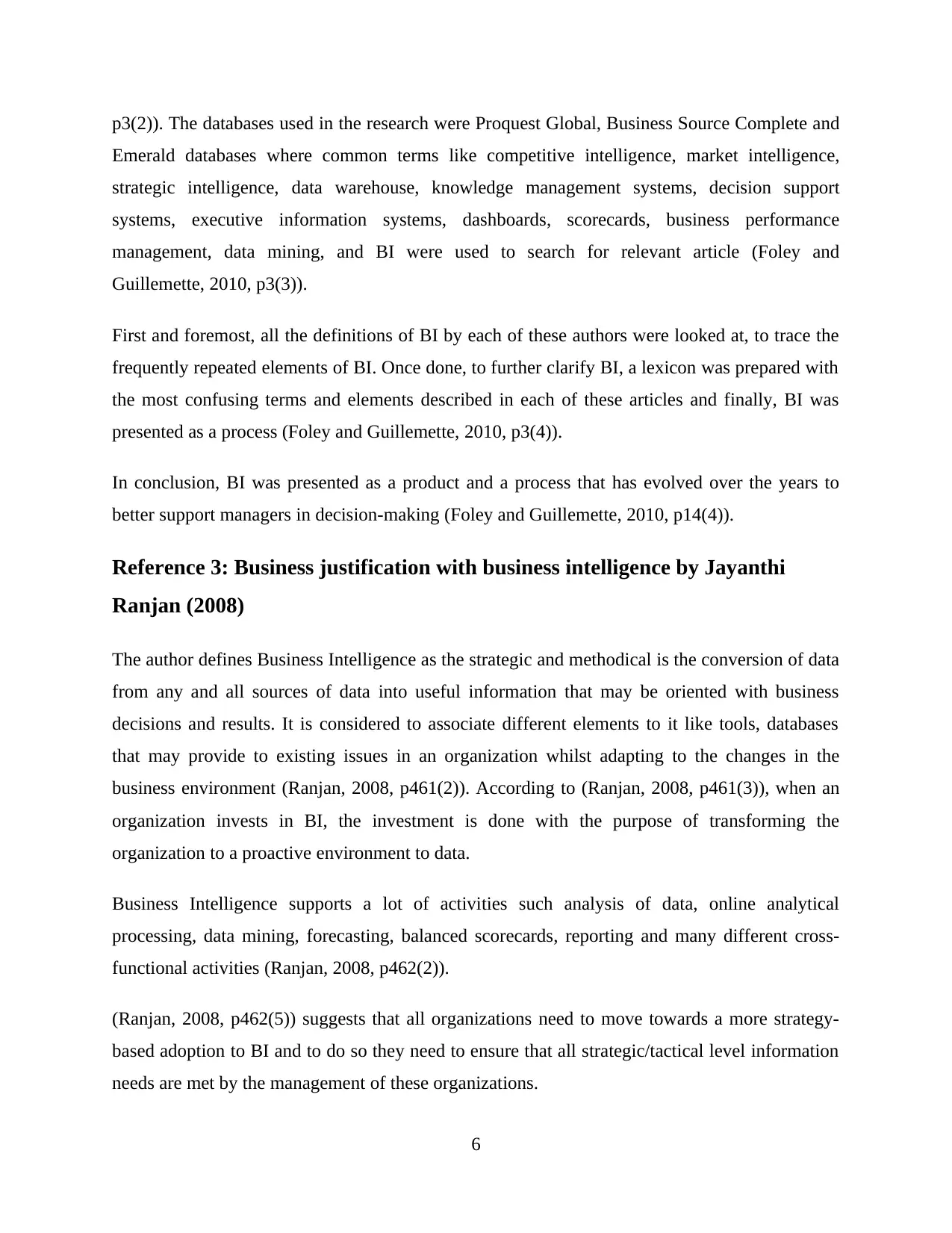
p3(2)). The databases used in the research were Proquest Global, Business Source Complete and
Emerald databases where common terms like competitive intelligence, market intelligence,
strategic intelligence, data warehouse, knowledge management systems, decision support
systems, executive information systems, dashboards, scorecards, business performance
management, data mining, and BI were used to search for relevant article (Foley and
Guillemette, 2010, p3(3)).
First and foremost, all the definitions of BI by each of these authors were looked at, to trace the
frequently repeated elements of BI. Once done, to further clarify BI, a lexicon was prepared with
the most confusing terms and elements described in each of these articles and finally, BI was
presented as a process (Foley and Guillemette, 2010, p3(4)).
In conclusion, BI was presented as a product and a process that has evolved over the years to
better support managers in decision-making (Foley and Guillemette, 2010, p14(4)).
Reference 3: Business justification with business intelligence by Jayanthi
Ranjan (2008)
The author defines Business Intelligence as the strategic and methodical is the conversion of data
from any and all sources of data into useful information that may be oriented with business
decisions and results. It is considered to associate different elements to it like tools, databases
that may provide to existing issues in an organization whilst adapting to the changes in the
business environment (Ranjan, 2008, p461(2)). According to (Ranjan, 2008, p461(3)), when an
organization invests in BI, the investment is done with the purpose of transforming the
organization to a proactive environment to data.
Business Intelligence supports a lot of activities such analysis of data, online analytical
processing, data mining, forecasting, balanced scorecards, reporting and many different cross-
functional activities (Ranjan, 2008, p462(2)).
(Ranjan, 2008, p462(5)) suggests that all organizations need to move towards a more strategy-
based adoption to BI and to do so they need to ensure that all strategic/tactical level information
needs are met by the management of these organizations.
6
Emerald databases where common terms like competitive intelligence, market intelligence,
strategic intelligence, data warehouse, knowledge management systems, decision support
systems, executive information systems, dashboards, scorecards, business performance
management, data mining, and BI were used to search for relevant article (Foley and
Guillemette, 2010, p3(3)).
First and foremost, all the definitions of BI by each of these authors were looked at, to trace the
frequently repeated elements of BI. Once done, to further clarify BI, a lexicon was prepared with
the most confusing terms and elements described in each of these articles and finally, BI was
presented as a process (Foley and Guillemette, 2010, p3(4)).
In conclusion, BI was presented as a product and a process that has evolved over the years to
better support managers in decision-making (Foley and Guillemette, 2010, p14(4)).
Reference 3: Business justification with business intelligence by Jayanthi
Ranjan (2008)
The author defines Business Intelligence as the strategic and methodical is the conversion of data
from any and all sources of data into useful information that may be oriented with business
decisions and results. It is considered to associate different elements to it like tools, databases
that may provide to existing issues in an organization whilst adapting to the changes in the
business environment (Ranjan, 2008, p461(2)). According to (Ranjan, 2008, p461(3)), when an
organization invests in BI, the investment is done with the purpose of transforming the
organization to a proactive environment to data.
Business Intelligence supports a lot of activities such analysis of data, online analytical
processing, data mining, forecasting, balanced scorecards, reporting and many different cross-
functional activities (Ranjan, 2008, p462(2)).
(Ranjan, 2008, p462(5)) suggests that all organizations need to move towards a more strategy-
based adoption to BI and to do so they need to ensure that all strategic/tactical level information
needs are met by the management of these organizations.
6
Paraphrase This Document
Need a fresh take? Get an instant paraphrase of this document with our AI Paraphraser
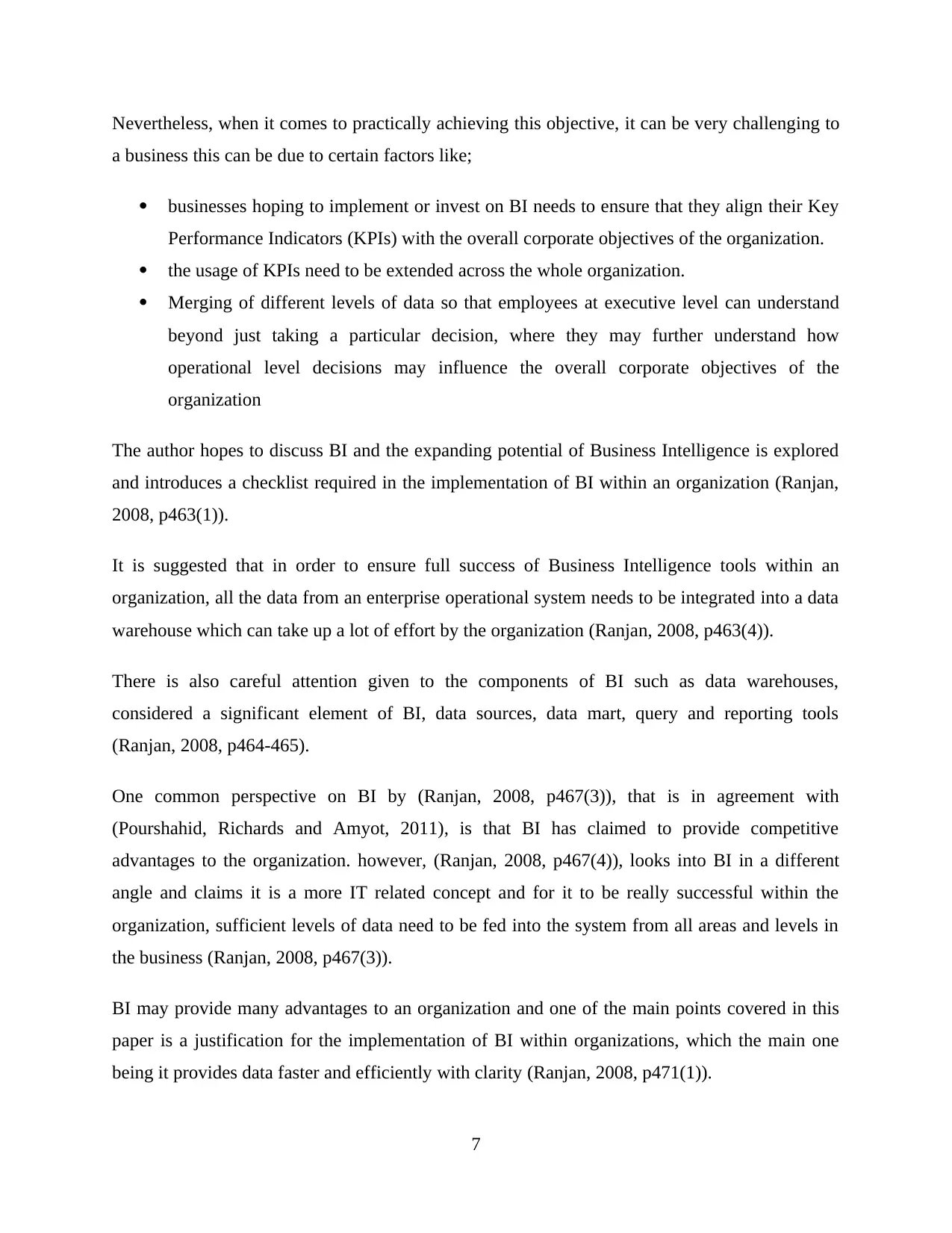
Nevertheless, when it comes to practically achieving this objective, it can be very challenging to
a business this can be due to certain factors like;
businesses hoping to implement or invest on BI needs to ensure that they align their Key
Performance Indicators (KPIs) with the overall corporate objectives of the organization.
the usage of KPIs need to be extended across the whole organization.
Merging of different levels of data so that employees at executive level can understand
beyond just taking a particular decision, where they may further understand how
operational level decisions may influence the overall corporate objectives of the
organization
The author hopes to discuss BI and the expanding potential of Business Intelligence is explored
and introduces a checklist required in the implementation of BI within an organization (Ranjan,
2008, p463(1)).
It is suggested that in order to ensure full success of Business Intelligence tools within an
organization, all the data from an enterprise operational system needs to be integrated into a data
warehouse which can take up a lot of effort by the organization (Ranjan, 2008, p463(4)).
There is also careful attention given to the components of BI such as data warehouses,
considered a significant element of BI, data sources, data mart, query and reporting tools
(Ranjan, 2008, p464-465).
One common perspective on BI by (Ranjan, 2008, p467(3)), that is in agreement with
(Pourshahid, Richards and Amyot, 2011), is that BI has claimed to provide competitive
advantages to the organization. however, (Ranjan, 2008, p467(4)), looks into BI in a different
angle and claims it is a more IT related concept and for it to be really successful within the
organization, sufficient levels of data need to be fed into the system from all areas and levels in
the business (Ranjan, 2008, p467(3)).
BI may provide many advantages to an organization and one of the main points covered in this
paper is a justification for the implementation of BI within organizations, which the main one
being it provides data faster and efficiently with clarity (Ranjan, 2008, p471(1)).
7
a business this can be due to certain factors like;
businesses hoping to implement or invest on BI needs to ensure that they align their Key
Performance Indicators (KPIs) with the overall corporate objectives of the organization.
the usage of KPIs need to be extended across the whole organization.
Merging of different levels of data so that employees at executive level can understand
beyond just taking a particular decision, where they may further understand how
operational level decisions may influence the overall corporate objectives of the
organization
The author hopes to discuss BI and the expanding potential of Business Intelligence is explored
and introduces a checklist required in the implementation of BI within an organization (Ranjan,
2008, p463(1)).
It is suggested that in order to ensure full success of Business Intelligence tools within an
organization, all the data from an enterprise operational system needs to be integrated into a data
warehouse which can take up a lot of effort by the organization (Ranjan, 2008, p463(4)).
There is also careful attention given to the components of BI such as data warehouses,
considered a significant element of BI, data sources, data mart, query and reporting tools
(Ranjan, 2008, p464-465).
One common perspective on BI by (Ranjan, 2008, p467(3)), that is in agreement with
(Pourshahid, Richards and Amyot, 2011), is that BI has claimed to provide competitive
advantages to the organization. however, (Ranjan, 2008, p467(4)), looks into BI in a different
angle and claims it is a more IT related concept and for it to be really successful within the
organization, sufficient levels of data need to be fed into the system from all areas and levels in
the business (Ranjan, 2008, p467(3)).
BI may provide many advantages to an organization and one of the main points covered in this
paper is a justification for the implementation of BI within organizations, which the main one
being it provides data faster and efficiently with clarity (Ranjan, 2008, p471(1)).
7
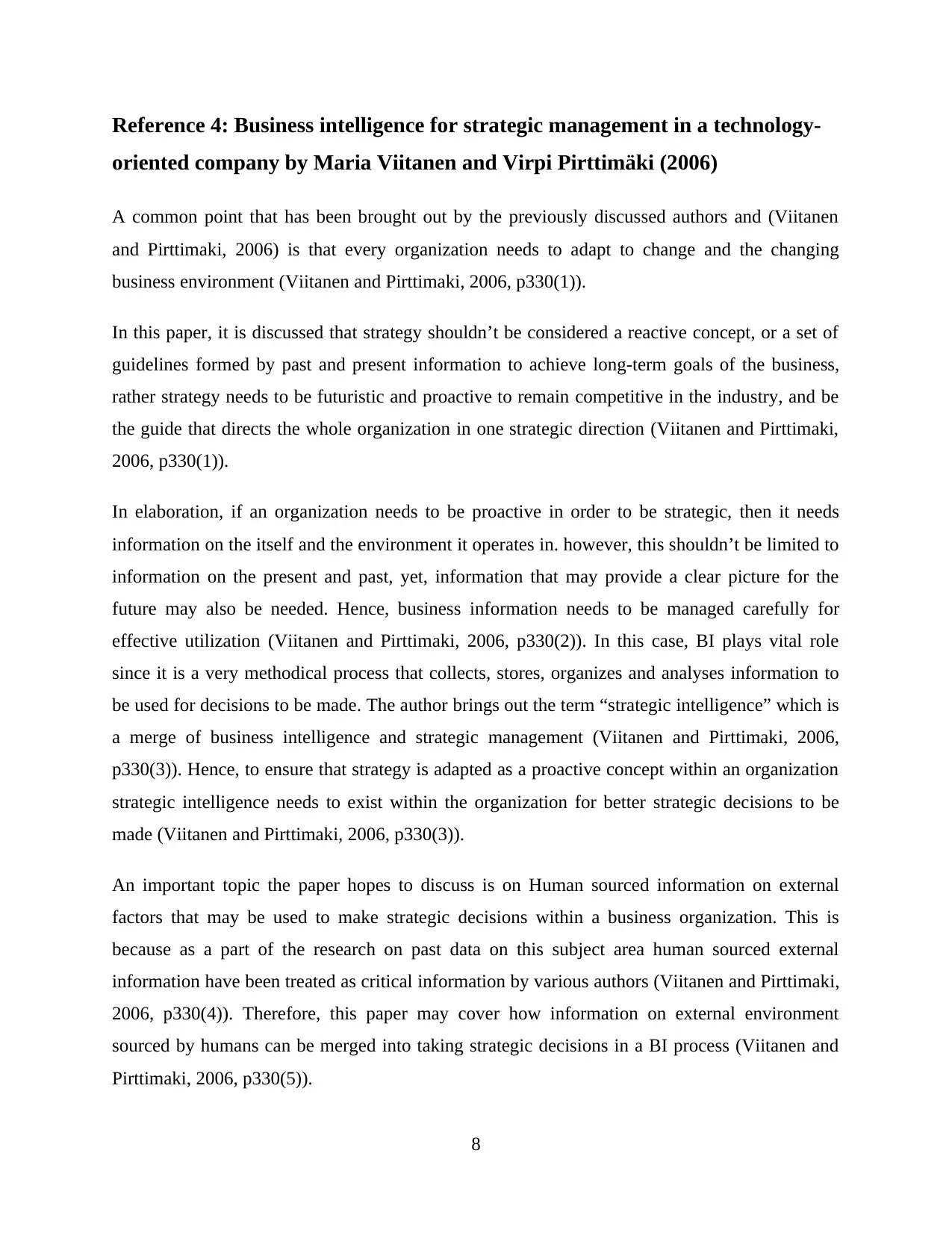
Reference 4: Business intelligence for strategic management in a technology-
oriented company by Maria Viitanen and Virpi Pirttimäki (2006)
A common point that has been brought out by the previously discussed authors and (Viitanen
and Pirttimaki, 2006) is that every organization needs to adapt to change and the changing
business environment (Viitanen and Pirttimaki, 2006, p330(1)).
In this paper, it is discussed that strategy shouldn’t be considered a reactive concept, or a set of
guidelines formed by past and present information to achieve long-term goals of the business,
rather strategy needs to be futuristic and proactive to remain competitive in the industry, and be
the guide that directs the whole organization in one strategic direction (Viitanen and Pirttimaki,
2006, p330(1)).
In elaboration, if an organization needs to be proactive in order to be strategic, then it needs
information on the itself and the environment it operates in. however, this shouldn’t be limited to
information on the present and past, yet, information that may provide a clear picture for the
future may also be needed. Hence, business information needs to be managed carefully for
effective utilization (Viitanen and Pirttimaki, 2006, p330(2)). In this case, BI plays vital role
since it is a very methodical process that collects, stores, organizes and analyses information to
be used for decisions to be made. The author brings out the term “strategic intelligence” which is
a merge of business intelligence and strategic management (Viitanen and Pirttimaki, 2006,
p330(3)). Hence, to ensure that strategy is adapted as a proactive concept within an organization
strategic intelligence needs to exist within the organization for better strategic decisions to be
made (Viitanen and Pirttimaki, 2006, p330(3)).
An important topic the paper hopes to discuss is on Human sourced information on external
factors that may be used to make strategic decisions within a business organization. This is
because as a part of the research on past data on this subject area human sourced external
information have been treated as critical information by various authors (Viitanen and Pirttimaki,
2006, p330(4)). Therefore, this paper may cover how information on external environment
sourced by humans can be merged into taking strategic decisions in a BI process (Viitanen and
Pirttimaki, 2006, p330(5)).
8
oriented company by Maria Viitanen and Virpi Pirttimäki (2006)
A common point that has been brought out by the previously discussed authors and (Viitanen
and Pirttimaki, 2006) is that every organization needs to adapt to change and the changing
business environment (Viitanen and Pirttimaki, 2006, p330(1)).
In this paper, it is discussed that strategy shouldn’t be considered a reactive concept, or a set of
guidelines formed by past and present information to achieve long-term goals of the business,
rather strategy needs to be futuristic and proactive to remain competitive in the industry, and be
the guide that directs the whole organization in one strategic direction (Viitanen and Pirttimaki,
2006, p330(1)).
In elaboration, if an organization needs to be proactive in order to be strategic, then it needs
information on the itself and the environment it operates in. however, this shouldn’t be limited to
information on the present and past, yet, information that may provide a clear picture for the
future may also be needed. Hence, business information needs to be managed carefully for
effective utilization (Viitanen and Pirttimaki, 2006, p330(2)). In this case, BI plays vital role
since it is a very methodical process that collects, stores, organizes and analyses information to
be used for decisions to be made. The author brings out the term “strategic intelligence” which is
a merge of business intelligence and strategic management (Viitanen and Pirttimaki, 2006,
p330(3)). Hence, to ensure that strategy is adapted as a proactive concept within an organization
strategic intelligence needs to exist within the organization for better strategic decisions to be
made (Viitanen and Pirttimaki, 2006, p330(3)).
An important topic the paper hopes to discuss is on Human sourced information on external
factors that may be used to make strategic decisions within a business organization. This is
because as a part of the research on past data on this subject area human sourced external
information have been treated as critical information by various authors (Viitanen and Pirttimaki,
2006, p330(4)). Therefore, this paper may cover how information on external environment
sourced by humans can be merged into taking strategic decisions in a BI process (Viitanen and
Pirttimaki, 2006, p330(5)).
8
⊘ This is a preview!⊘
Do you want full access?
Subscribe today to unlock all pages.

Trusted by 1+ million students worldwide
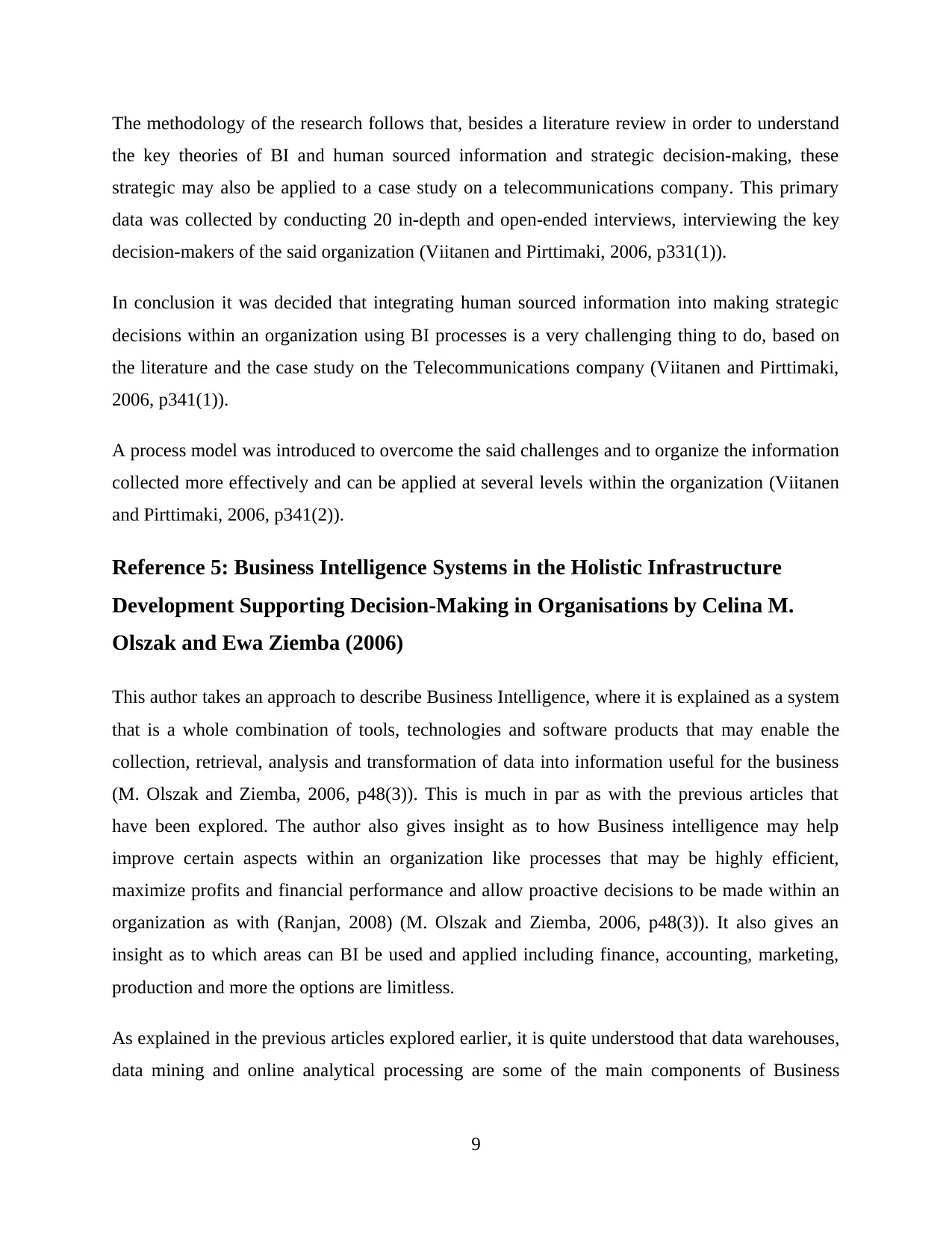
The methodology of the research follows that, besides a literature review in order to understand
the key theories of BI and human sourced information and strategic decision-making, these
strategic may also be applied to a case study on a telecommunications company. This primary
data was collected by conducting 20 in-depth and open-ended interviews, interviewing the key
decision-makers of the said organization (Viitanen and Pirttimaki, 2006, p331(1)).
In conclusion it was decided that integrating human sourced information into making strategic
decisions within an organization using BI processes is a very challenging thing to do, based on
the literature and the case study on the Telecommunications company (Viitanen and Pirttimaki,
2006, p341(1)).
A process model was introduced to overcome the said challenges and to organize the information
collected more effectively and can be applied at several levels within the organization (Viitanen
and Pirttimaki, 2006, p341(2)).
Reference 5: Business Intelligence Systems in the Holistic Infrastructure
Development Supporting Decision-Making in Organisations by Celina M.
Olszak and Ewa Ziemba (2006)
This author takes an approach to describe Business Intelligence, where it is explained as a system
that is a whole combination of tools, technologies and software products that may enable the
collection, retrieval, analysis and transformation of data into information useful for the business
(M. Olszak and Ziemba, 2006, p48(3)). This is much in par as with the previous articles that
have been explored. The author also gives insight as to how Business intelligence may help
improve certain aspects within an organization like processes that may be highly efficient,
maximize profits and financial performance and allow proactive decisions to be made within an
organization as with (Ranjan, 2008) (M. Olszak and Ziemba, 2006, p48(3)). It also gives an
insight as to which areas can BI be used and applied including finance, accounting, marketing,
production and more the options are limitless.
As explained in the previous articles explored earlier, it is quite understood that data warehouses,
data mining and online analytical processing are some of the main components of Business
9
the key theories of BI and human sourced information and strategic decision-making, these
strategic may also be applied to a case study on a telecommunications company. This primary
data was collected by conducting 20 in-depth and open-ended interviews, interviewing the key
decision-makers of the said organization (Viitanen and Pirttimaki, 2006, p331(1)).
In conclusion it was decided that integrating human sourced information into making strategic
decisions within an organization using BI processes is a very challenging thing to do, based on
the literature and the case study on the Telecommunications company (Viitanen and Pirttimaki,
2006, p341(1)).
A process model was introduced to overcome the said challenges and to organize the information
collected more effectively and can be applied at several levels within the organization (Viitanen
and Pirttimaki, 2006, p341(2)).
Reference 5: Business Intelligence Systems in the Holistic Infrastructure
Development Supporting Decision-Making in Organisations by Celina M.
Olszak and Ewa Ziemba (2006)
This author takes an approach to describe Business Intelligence, where it is explained as a system
that is a whole combination of tools, technologies and software products that may enable the
collection, retrieval, analysis and transformation of data into information useful for the business
(M. Olszak and Ziemba, 2006, p48(3)). This is much in par as with the previous articles that
have been explored. The author also gives insight as to how Business intelligence may help
improve certain aspects within an organization like processes that may be highly efficient,
maximize profits and financial performance and allow proactive decisions to be made within an
organization as with (Ranjan, 2008) (M. Olszak and Ziemba, 2006, p48(3)). It also gives an
insight as to which areas can BI be used and applied including finance, accounting, marketing,
production and more the options are limitless.
As explained in the previous articles explored earlier, it is quite understood that data warehouses,
data mining and online analytical processing are some of the main components of Business
9
Paraphrase This Document
Need a fresh take? Get an instant paraphrase of this document with our AI Paraphraser
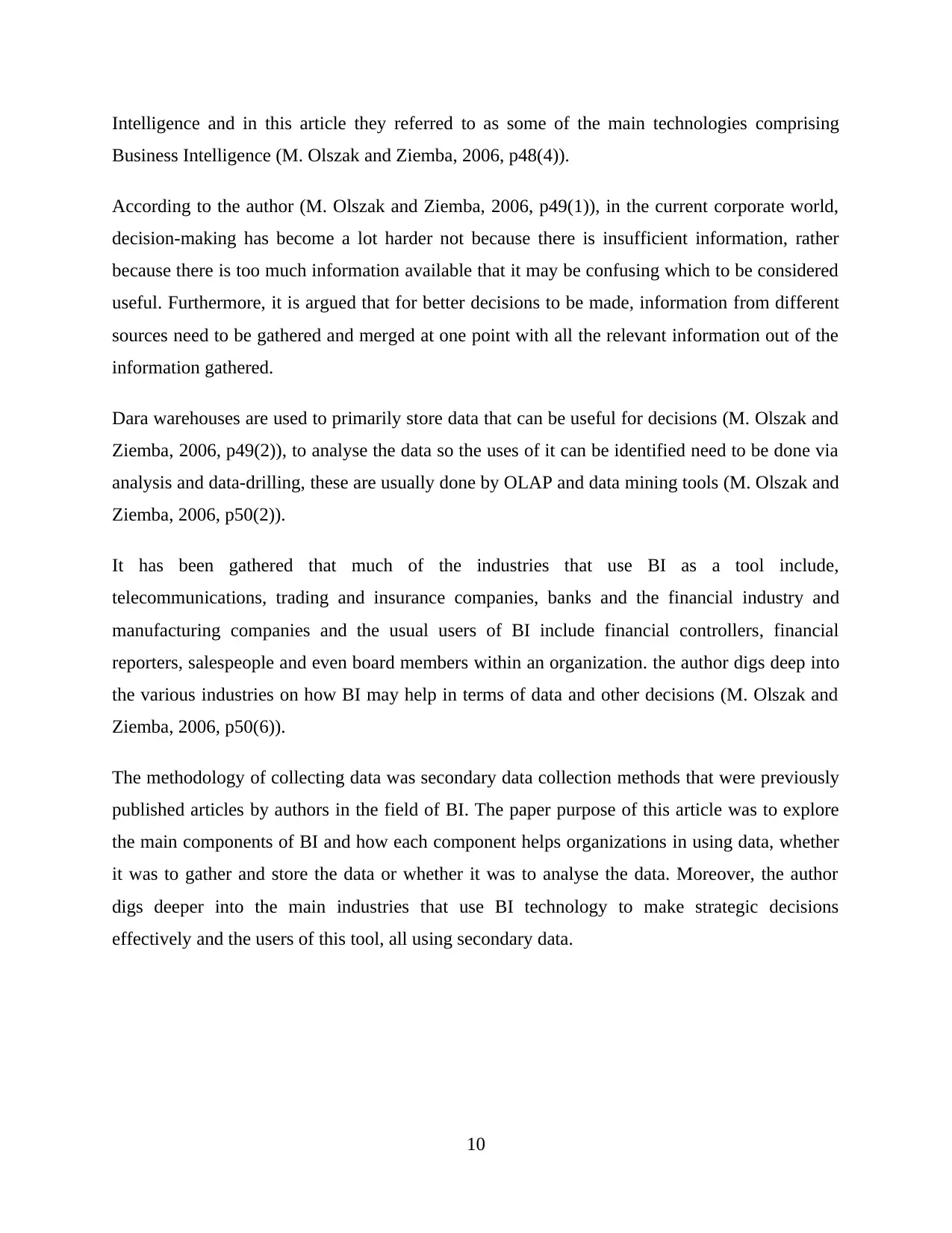
Intelligence and in this article they referred to as some of the main technologies comprising
Business Intelligence (M. Olszak and Ziemba, 2006, p48(4)).
According to the author (M. Olszak and Ziemba, 2006, p49(1)), in the current corporate world,
decision-making has become a lot harder not because there is insufficient information, rather
because there is too much information available that it may be confusing which to be considered
useful. Furthermore, it is argued that for better decisions to be made, information from different
sources need to be gathered and merged at one point with all the relevant information out of the
information gathered.
Dara warehouses are used to primarily store data that can be useful for decisions (M. Olszak and
Ziemba, 2006, p49(2)), to analyse the data so the uses of it can be identified need to be done via
analysis and data-drilling, these are usually done by OLAP and data mining tools (M. Olszak and
Ziemba, 2006, p50(2)).
It has been gathered that much of the industries that use BI as a tool include,
telecommunications, trading and insurance companies, banks and the financial industry and
manufacturing companies and the usual users of BI include financial controllers, financial
reporters, salespeople and even board members within an organization. the author digs deep into
the various industries on how BI may help in terms of data and other decisions (M. Olszak and
Ziemba, 2006, p50(6)).
The methodology of collecting data was secondary data collection methods that were previously
published articles by authors in the field of BI. The paper purpose of this article was to explore
the main components of BI and how each component helps organizations in using data, whether
it was to gather and store the data or whether it was to analyse the data. Moreover, the author
digs deeper into the main industries that use BI technology to make strategic decisions
effectively and the users of this tool, all using secondary data.
10
Business Intelligence (M. Olszak and Ziemba, 2006, p48(4)).
According to the author (M. Olszak and Ziemba, 2006, p49(1)), in the current corporate world,
decision-making has become a lot harder not because there is insufficient information, rather
because there is too much information available that it may be confusing which to be considered
useful. Furthermore, it is argued that for better decisions to be made, information from different
sources need to be gathered and merged at one point with all the relevant information out of the
information gathered.
Dara warehouses are used to primarily store data that can be useful for decisions (M. Olszak and
Ziemba, 2006, p49(2)), to analyse the data so the uses of it can be identified need to be done via
analysis and data-drilling, these are usually done by OLAP and data mining tools (M. Olszak and
Ziemba, 2006, p50(2)).
It has been gathered that much of the industries that use BI as a tool include,
telecommunications, trading and insurance companies, banks and the financial industry and
manufacturing companies and the usual users of BI include financial controllers, financial
reporters, salespeople and even board members within an organization. the author digs deep into
the various industries on how BI may help in terms of data and other decisions (M. Olszak and
Ziemba, 2006, p50(6)).
The methodology of collecting data was secondary data collection methods that were previously
published articles by authors in the field of BI. The paper purpose of this article was to explore
the main components of BI and how each component helps organizations in using data, whether
it was to gather and store the data or whether it was to analyse the data. Moreover, the author
digs deeper into the main industries that use BI technology to make strategic decisions
effectively and the users of this tool, all using secondary data.
10
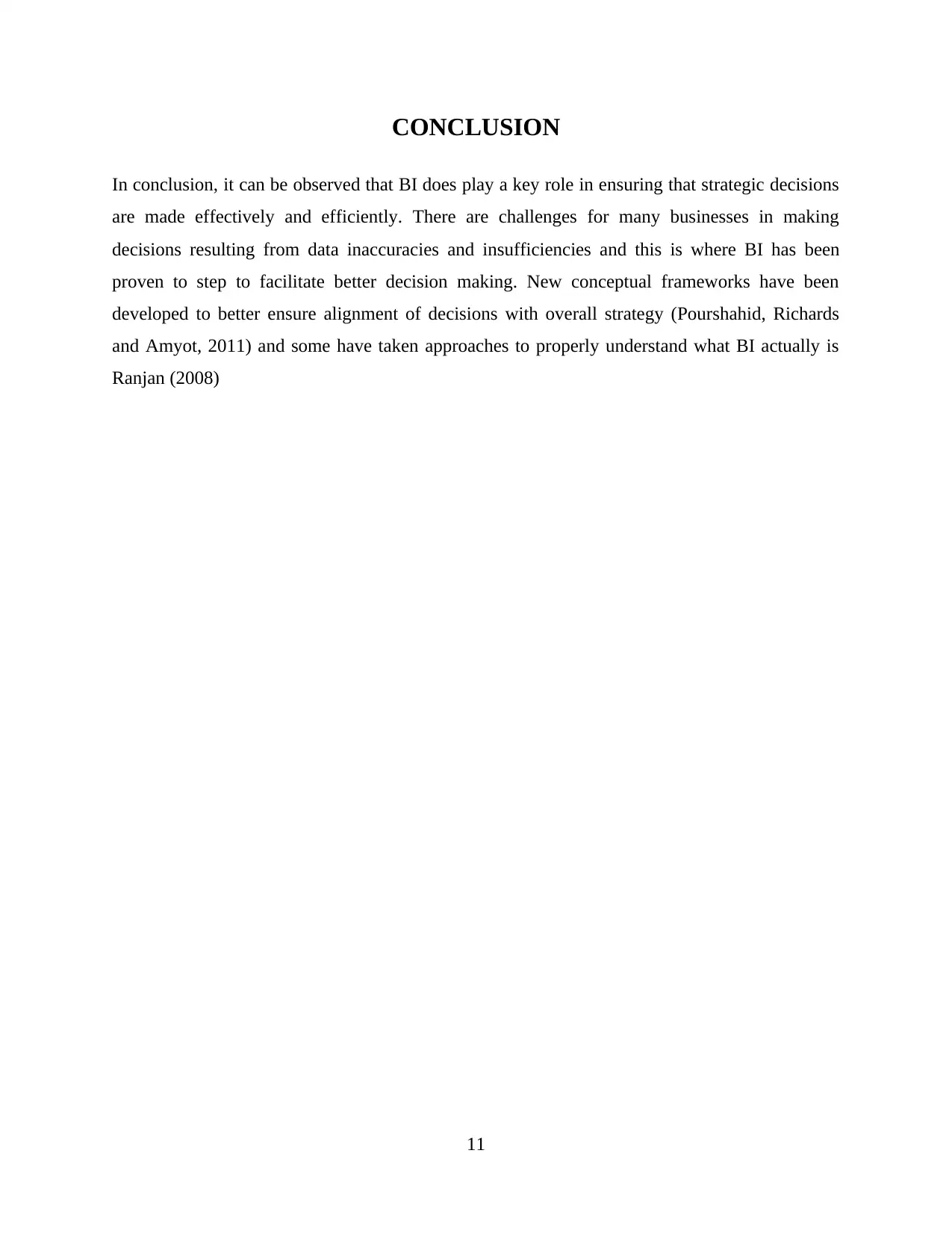
CONCLUSION
In conclusion, it can be observed that BI does play a key role in ensuring that strategic decisions
are made effectively and efficiently. There are challenges for many businesses in making
decisions resulting from data inaccuracies and insufficiencies and this is where BI has been
proven to step to facilitate better decision making. New conceptual frameworks have been
developed to better ensure alignment of decisions with overall strategy (Pourshahid, Richards
and Amyot, 2011) and some have taken approaches to properly understand what BI actually is
Ranjan (2008)
11
In conclusion, it can be observed that BI does play a key role in ensuring that strategic decisions
are made effectively and efficiently. There are challenges for many businesses in making
decisions resulting from data inaccuracies and insufficiencies and this is where BI has been
proven to step to facilitate better decision making. New conceptual frameworks have been
developed to better ensure alignment of decisions with overall strategy (Pourshahid, Richards
and Amyot, 2011) and some have taken approaches to properly understand what BI actually is
Ranjan (2008)
11
⊘ This is a preview!⊘
Do you want full access?
Subscribe today to unlock all pages.

Trusted by 1+ million students worldwide
1 out of 13
Related Documents
Your All-in-One AI-Powered Toolkit for Academic Success.
+13062052269
info@desklib.com
Available 24*7 on WhatsApp / Email
![[object Object]](/_next/static/media/star-bottom.7253800d.svg)
Unlock your academic potential
Copyright © 2020–2025 A2Z Services. All Rights Reserved. Developed and managed by ZUCOL.



